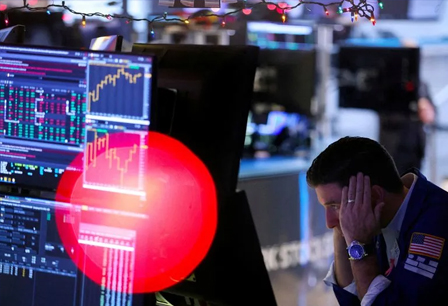U.S. stocks closed lower Tuesday, the final session of May, as Treasury yields pushed higher following last week’s equity market bounce after a historic string of weekly losses. The Dow Jones Industrial Average and the S&P 500 each eked out gains in May, while the Nasdaq Composite fell for a second straight month, according to Dow Jones Market Data.
How did stocks perform?
The Dow Jones Industrial Average DJIA, -0.67% fell 222.84 points, or 0.7%, to close at 32,990.12, snapping a winning streak of six straight days.
The S&P 500 SPX, -0.63% slipped 26.09 points, or 0.6%, to finish at 4,132.15, snapping a three-day winning streak.
The Nasdaq Composite COMP, -0.41% lost 49.74 points, or 0.4%, to end at 12,081.39, also snapping winning streak of three straight days.
Stocks bounced sharply last week, with the Dow Jones Industrial Average rising 6.2% to snap a run of eight straight weekly losses — its longest since 1932. The S&P 500, which earlier this month came within a whisker of the arbitrary 20% pullback threshold that marks a bear market, rose 6.6% last week for its biggest weekly gain since March 2020, while the Nasdaq Composite, which fell into a bear market earlier this year, rose 6.8%.
In May, the Dow and S&P 500 each eked out a gain of less than 0.1% while the Nasdaq fell 2.1%.
What drove markets?
In the final day of the month, the bounce from recent lows appeared to be stalling.
“I don’t think we’ve seen the bottom,” said Steve Sosnick, chief strategist at Interactive Brokers, in a phone interview Tuesday. Investors “haven’t thrown in the towel,” he said, meaning they haven’t yet capitulated in this year’s slump.
Analysts said last week’s bounce was technically overdue, coming as the selloff that took the S&P 500 to the brink of a bear market on May 19 left the market stretched to the downside by several measures.
The move to the downside saw steep sector selloffs that ranged from -2.6% for consumer staples to 34.3% for consumer discretionary, while the percentage of subindustries trading below their 50- and 200-day moving averages were more than two standard deviations below their 27-year means, noted Sam Stovall, chief investment strategist at CFRA, in a note. The S&P 500 12-month forward earnings-per-share estimates declined to 16.8 times price — down 1.1% from its 20-plus year average and the lowest reading since April 2020.
“These extremes hinted quite loudly that, like the release of an overstretched rubber band, the market was primed for at least a short-term snapback,” Stovall said. “And snap it did…The only question remaining is whether this rally will extend or evaporate. We remain skeptical of this rally’s sustainability.”
A hawkish speech delivered Monday by Christopher Waller, a Fed governor, didn’t seem to help sentiment in early trade. Waller said he supports half percentage point interest rate increases until there are signs inflation is cooling toward its 2% target. The core reading of the Fed’s preferred inflation gauge was 4.9% in April.
The yield on the 10-year Treasury TMUBMUSD10Y, 2.873% note rose 9.4 basis points Tuesday to 2.842%, according to Dow Jones Market Data.
U.S. stocks closed lower Tuesday, the final session of May, as Treasury yields pushed higher following last week’s equity market bounce after a historic string of weekly losses. The Dow Jones Industrial Average and the S&P 500 each eked out gains in May, while the Nasdaq Composite fell for a second straight month, according to Dow Jones Market Data.
How did stocks perform?
The Dow Jones Industrial Average DJIA, -0.67% fell 222.84 points, or 0.7%, to close at 32,990.12, snapping a winning streak of six straight days.
The S&P 500 SPX, -0.63% slipped 26.09 points, or 0.6%, to finish at 4,132.15, snapping a three-day winning streak.
The Nasdaq Composite COMP, -0.41% lost 49.74 points, or 0.4%, to end at 12,081.39, also snapping winning streak of three straight days.
Stocks bounced sharply last week, with the Dow Jones Industrial Average rising 6.2% to snap a run of eight straight weekly losses — its longest since 1932. The S&P 500, which earlier this month came within a whisker of the arbitrary 20% pullback threshold that marks a bear market, rose 6.6% last week for its biggest weekly gain since March 2020, while the Nasdaq Composite, which fell into a bear market earlier this year, rose 6.8%.
In May, the Dow and S&P 500 each eked out a gain of less than 0.1% while the Nasdaq fell 2.1%.
What drove markets?
In the final day of the month, the bounce from recent lows appeared to be stalling.
“I don’t think we’ve seen the bottom,” said Steve Sosnick, chief strategist at Interactive Brokers, in a phone interview Tuesday. Investors “haven’t thrown in the towel,” he said, meaning they haven’t yet capitulated in this year’s slump.
Analysts said last week’s bounce was technically overdue, coming as the selloff that took the S&P 500 to the brink of a bear market on May 19 left the market stretched to the downside by several measures.
The move to the downside saw steep sector selloffs that ranged from -2.6% for consumer staples to 34.3% for consumer discretionary, while the percentage of subindustries trading below their 50- and 200-day moving averages were more than two standard deviations below their 27-year means, noted Sam Stovall, chief investment strategist at CFRA, in a note. The S&P 500 12-month forward earnings-per-share estimates declined to 16.8 times price — down 1.1% from its 20-plus year average and the lowest reading since April 2020.
“These extremes hinted quite loudly that, like the release of an overstretched rubber band, the market was primed for at least a short-term snapback,” Stovall said. “And snap it did…The only question remaining is whether this rally will extend or evaporate. We remain skeptical of this rally’s sustainability.”
A hawkish speech delivered Monday by Christopher Waller, a Fed governor, didn’t seem to help sentiment in early trade. Waller said he supports half percentage point interest rate increases until there are signs inflation is cooling toward its 2% target. The core reading of the Fed’s preferred inflation gauge was 4.9% in April.
The yield on the 10-year Treasury TMUBMUSD10Y, 2.873% note rose 9.4 basis points Tuesday to 2.842%, according to Dow Jones Market Data.












